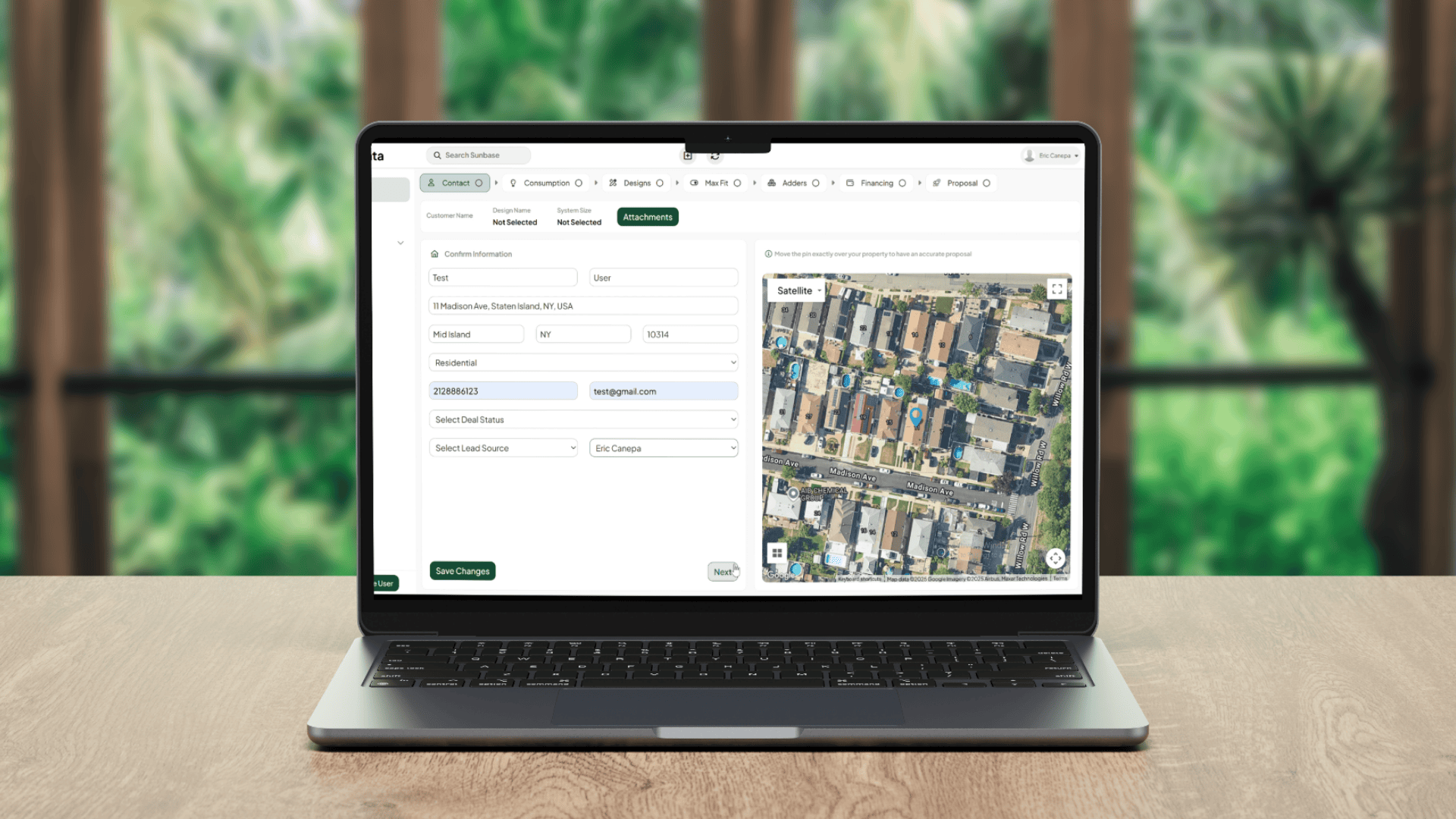August 31, 2025
Audio overview: Listen & Learn
If you run a solar system company in Canada, you already know that the tools weren't built for you, but were built
for the U.S. market with uniform grids, single-language teams, and policies that don’t shift every 200 kilometers.
But here? You’re dealing with bilingual crews, five different net metering policies, and a solar system sales cycle that’s anything but simple. And yet, most solar software still treats Canada like a footnote.
Top Solar Software Challenges in Canada (2025 Edition)
This blog takes a closer look at what’s missing from the current landscape of solar software in Canada and how forward-thinking companies are adapting with tools that speak their language, match their province, and work end-to-end.
Key Takeaways
- Canadian solar companies face unique software challenges, including compliance, bilingual support, and provincial net metering differences.
- Most tools aren't built for Canada's fragmented policies or operational workflows, leaving teams stuck with systems that are out of sync.
- Common issues of solar software Canada include slow solar proposals, separate solar design software, and a lack of visibility into project management.
- All-in-one platforms like Sunbase help solve these challenges by streamlining solar operations, enabling faster installs, and improving team coordination.
Why Solar Companies in Canada Need Better Software in 2025

Canadian solar companies aren’t just managing installs, they’re navigating a maze of shifting policies, provincial rules, and unpredictable workflows. And the software they’re using? It’s often built for a completely different market.
Here’s why that’s a problem and what modern solar teams need instead:
A. A Rapidly Growing Renewable Energy Market
The Canadian renewable energy sector is gaining serious momentum. Provinces like Alberta and Ontario are scaling solar fast, but to keep up, companies need digital infrastructure that can move just as quickly.
B. One Country, Multiple Systems
Canada isn’t one unified solar market. Net metering in Ontario differs from that in British Columbia, and local utilities have their own approval rules. This means that your teams need software that adapts, not one-size-fits-all platforms.
C. Tools Built for the U.S. Fall Short
Most popular solar design software was built with U.S. policies, permitting workflows, and English-only interfaces in mind. These tools often fail to meet Canada’s dual-language needs or comply with the required formats.
D. The Result: Slower Growth, More Errors
Without the right tech stack, solar businesses face proposal delays, design rework, and poor communication between sales, ops, and installers. The gap between potential and execution keeps growing.
E. The Solution: Region-Specific, All-in-One Platforms
Modern solar teams need software tailored to their geography. Platforms like Sunbase combine design, CRM, and install tracking in one system, designed to match the way Canadian solar companies operate.
Challenge #1 – Navigating Compliance & Net Metering Rules

Navigating policy in Canada is a full-time job. Every province sets its own solar rules, utility expectations, and net metering conditions. But most solar software assumes you're working in a unified market.
That’s the first breakdown. And it’s costing your solar teams time, money, and trust.
A. Compliance Isn’t One-Size-Fits-All
In Canada, compliance is more than just building code; it is about aligning with provincial legislation, municipal permitting processes, and utility-specific workflows.
Let’s take Ontario, for example. It requires detailed engineering reports, ESA approvals, and documentation that follows a set naming and submission format. Quebec has a different structure entirely, with French-language documents and Hydro-Québec-specific application steps.
Most solar software doesn’t know the difference. This means teams often create their templates, manually double-check every application, or rely on offline paperwork, which slows down operations and creates opportunities for costly mistakes.
B. Net Metering in Canada Is Anything But Standard
Net metering Canada programs look different in every province:
- Ontario: It has a well-established net metering program, but system size, customer eligibility, and connection rules are tightly regulated.
- Alberta: Operates in a deregulated energy market where distributed generation rules vary by utility.
- British Columbia: BC Hydro offers net metering, but policy interpretations shift over time.
- Nova Scotia, Saskatchewan, and Manitoba: Each has different connection caps, approval timelines, and paperwork.
Most software platforms are built with one baseline assumption, usually U.S. net metering logic. This results in inaccurate modeling, missing application fields, and delays when designs are submitted for interconnection.
C. Manual Work Means Higher Risk
Without built-in compliance logic or localized workflows, solar teams are left handling these variations manually.
This means:
- Cross-referencing utility PDFs for each job
- Creating separate design packages for each province
- Using spreadsheets to track where a system is in the permit/approval process
- Delays when documentation is rejected or returned for revision
These friction points scale quickly, especially as teams take on more projects or expand to new provinces.
D. What Solar Teams Actually Need
Canadian solar companies need software that accounts for regional diversity at the core.
This means tools that:
- Adapt automatically based on province and utility
- Include pre-loaded forms or compliance templates
- Offer dynamic checklists for specific jurisdictions
- Let sales teams see upfront if a system is eligible under net metering rules
- Sync with project timelines and CRM records to avoid gaps
E. How Sunbase Solves It
Sunbase is built with real-world solar issues in mind, especially in fragmented regions like Canada.
The platform allows teams to:
- Generate province-compliant documents directly from the platform
- Track project approvals within a single dashboard
- Avoid redesigns caused by mismatched system specs
- Maintain a smooth flow between design, sales, and install ops without switching platforms
Instead of duct-taping multiple tools together and hoping for the best, Canadian solar companies can use one system that keeps them aligned, audit-ready, and on schedule.
Check out: How Solar CRM Software Helps Canadian Contractors Streamline Operations
Challenge #2 – Poor Localization and Lack of French Support
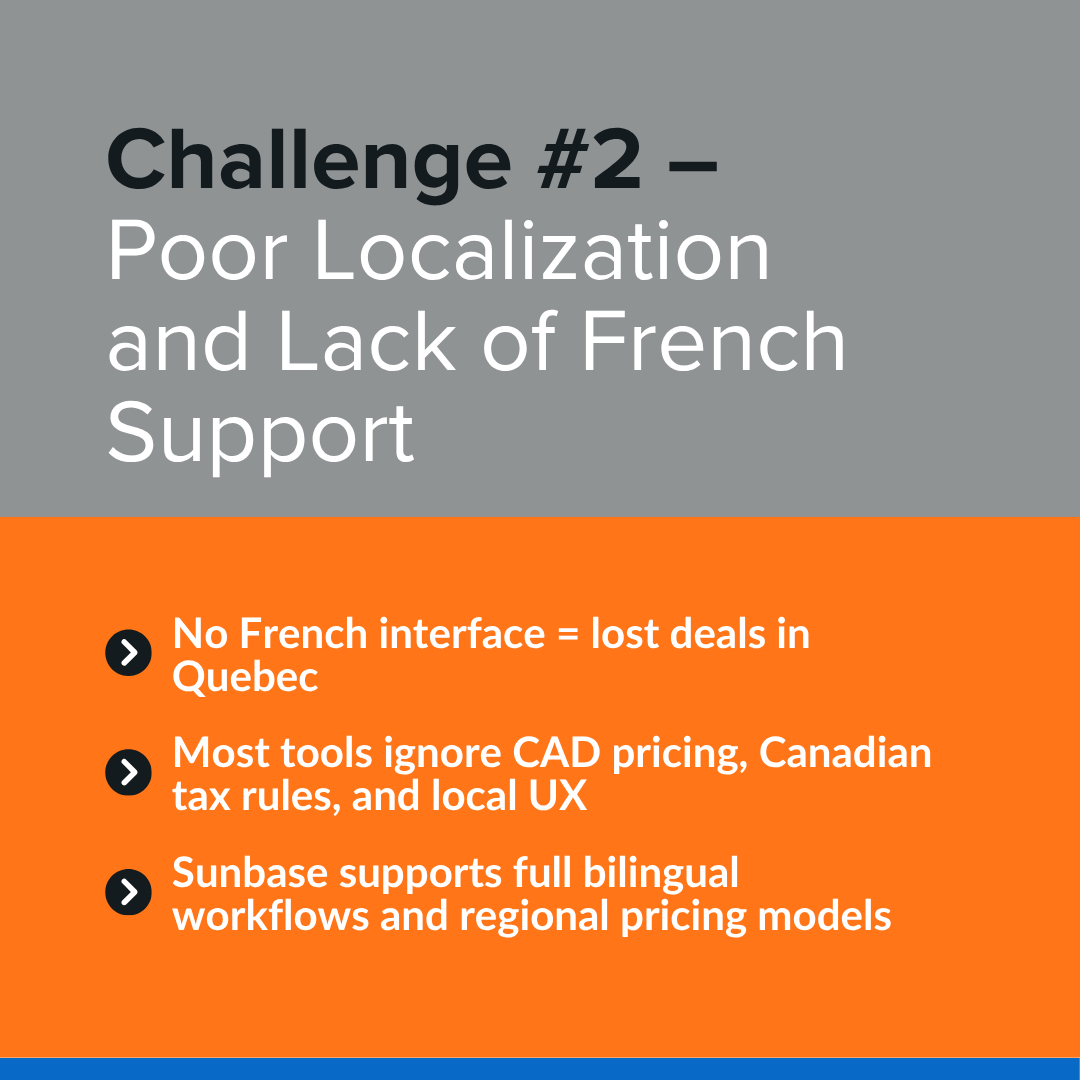
Canada is a bilingual country, but most solar software doesn’t act like it.
For solar companies operating in Quebec or supporting diverse teams, poor localization isn't just a minor annoyance. It’s a barrier to growth, training, and professionalism.
And it goes beyond language. Currency formatting, tax rules, and UX flow- most tools on final installation feel like they were built for a completely different market.
A. Quebec: A Market Often Left Behind
In Quebec, French-language documentation is legally required in many parts of the sales and permitting process.
Yet most solar CRMs, proposal builders, and management software offer no French-language interface.
Sales teams and most project managers are stuck translating proposals manually, and installation teams work from English-based instructions. The result? Friction, confusion, and slower workflows across the board.
Even if your business operates elsewhere, the inability to serve Quebec’s large, untapped market is a major missed opportunity.
B. More Than Language: Localization Includes UX, Currency, and Taxation
Localization is more than translation. Canadian solar companies deal with:
- Province-specific taxes (HST, GST, PST variations)
- Different financing logic depending on the region
- CAD pricing models that don’t always map to USD-based templates
- Local utility naming conventions and meter labeling
Most foreign-built tools don’t reflect this, leaving teams to “edit around” limitations or use patchwork workarounds.
Even minor details, such as address formats, date notations, and number formatting, can disrupt a smooth workflow when platforms aren’t truly localized.
C. Impacts on Training and Team Collaboration
Software that doesn’t reflect your team’s language or context slows everything down.
- Sales teams need extra time to translate proposals
- New hires take longer to onboard
- Internal documentation often lives outside the tool, creating silos
- Mistakes creep in because workflows aren’t aligned across language or regional expectations
This is especially painful for growing solar teams with mixed-language crews, remote sales offices, or subcontractors working across provincial borders.
D. What Canadian Solar Companies Need
Localization is foundational, and to serve Canadian customers and manage operations efficiently, solar teams
need:
- Full French-language interface support
- Localized proposal templates with editable CAD pricing and tax logic
- Tools that display relevant regulatory notices and utility formatting
- CRM and management software that accommodates bilingual internal workflows
E. How Sunbase Addresses This
Sunbase is designed with team dynamics in mind, including bilingual needs.
- Teams can build proposals and internal workflows in both English and French.
- CAD pricing and local tax settings are fully supported
- Permissions, workflows, and dashboards can be customized to match your team structure
- Whether you're operating in Quebec, Ontario, or both, Sunbase helps your sales and install teams stay aligned
No more translating tools built for another market. With Sunbase, your system speaks your team's language.
Challenge #3 – Platforms Across Design, Sales, and Project Management
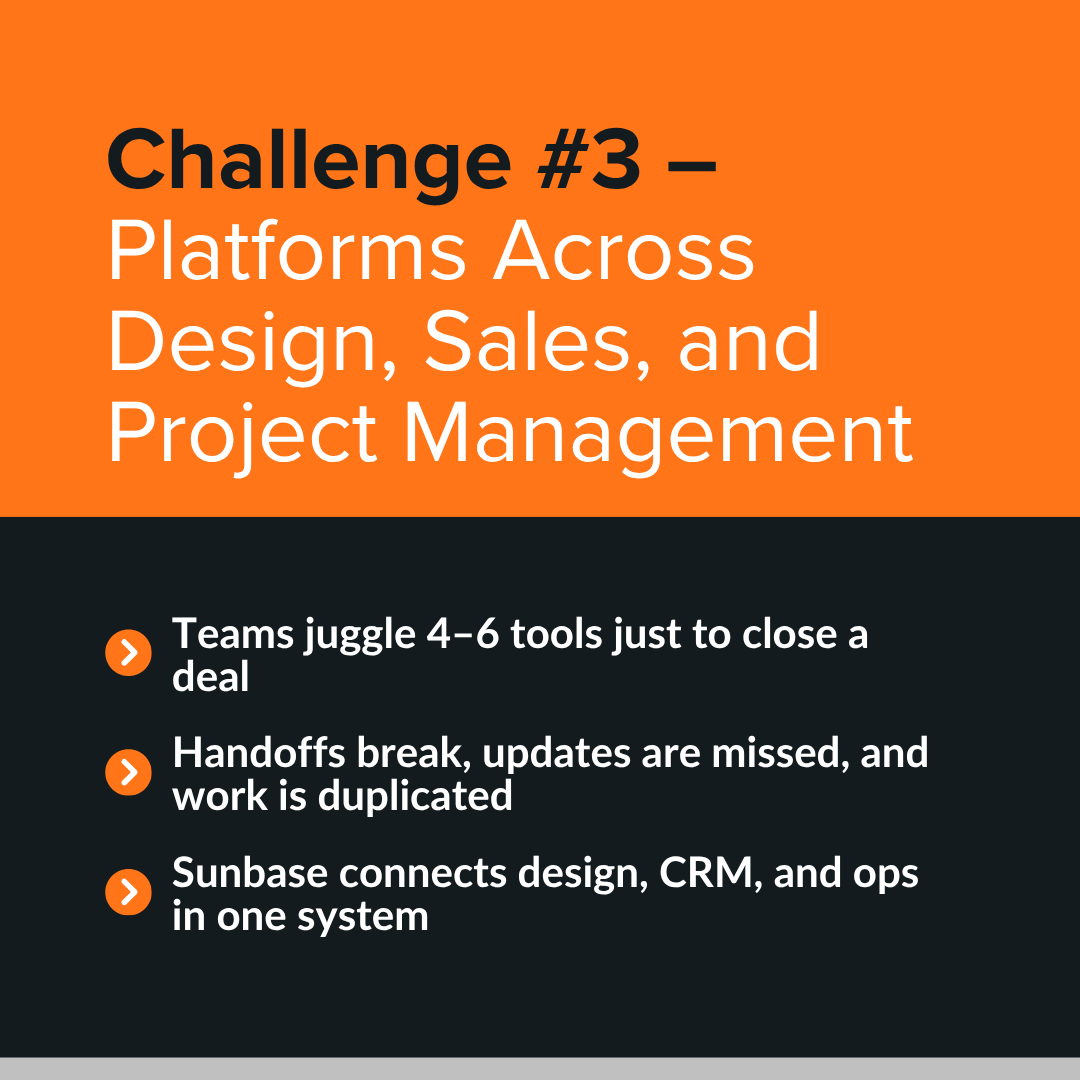
Most Canadian solar companies don’t have the luxury of big teams or IT departments. But they do have big goals, and juggling different tools for commercial projects is slowing them down.
From solar design to customer handoff, the tech stack has become a patchwork of tools that weren’t built to work together.
The result? Lost time. Missed handoffs. Frustrated teams.
A. The Reality of the Average Solar Stack
Ask any growing solar company in Canada what tools they use, and the answer will probably sound like this:
- Aurora or Helioscope for design
- A separate CRM like HubSpot or Zoho
- Google Docs or Canva for proposals
- Spreadsheets for project tracking
- Email and WhatsApp for communication
Each tool might be excellent on its own. But together, they create friction that compounds with every handoff between sales, ops, and installation teams.
B. The Impact on Workflow
Scattered platforms create operational blind spots that slow down every part of the process:
- Sales teams can't see where a project stands post-sale
- Designers don’t get real-time customer or site updates
- Ops teams spend hours reconciling files, fixing errors, or repeating tasks
- Managers lack visibility into bottlenecks, delays, or accountability
This is especially painful in solar operations where permits, timelines, and client expectations are tightly interlinked.
C. The Cost of Switching Context
Every time a team member jumps between tools, they lose time, not just in action, but in mental context switching.
According to productivity studies, switching between platforms can waste up to 40% of someone’s day. In solar? That can mean one less site design, one less proposal sent, or one more missed installation deadline.
And for companies with lean staff and regional spread, this adds up fast and affects long-term success.
D. What Integrated Systems Solve
An all-in-one system works smarter and is a game-changer.
Solar companies that use unified project management software see benefits like:
- Single customer records from lead to install
- Automatic sync between proposal changes and design revisions
- Central dashboards for sales, ops, and management
- Fewer tools, fewer tabs, fewer mistakes
It’s about making more deals happen with less overhead and more efficiency.
E. How Sunbase Unifies the Workflow
Sunbase is designed to bring solar teams under one roof:
- Start with a lead → build a proposal → convert it → track the install — all in one platform
- No exporting, no re-uploading, no copy-pasting between apps
- Role-based views give sales teams, designers, and ops the visibility they need.
- Real-time updates flow between departments, keeping everyone on the same page.
For Canadian solar companies operating efficiently, that kind of system is a necessity.
Challenge #4 – Slower Solar Proposals and Missed Opportunities
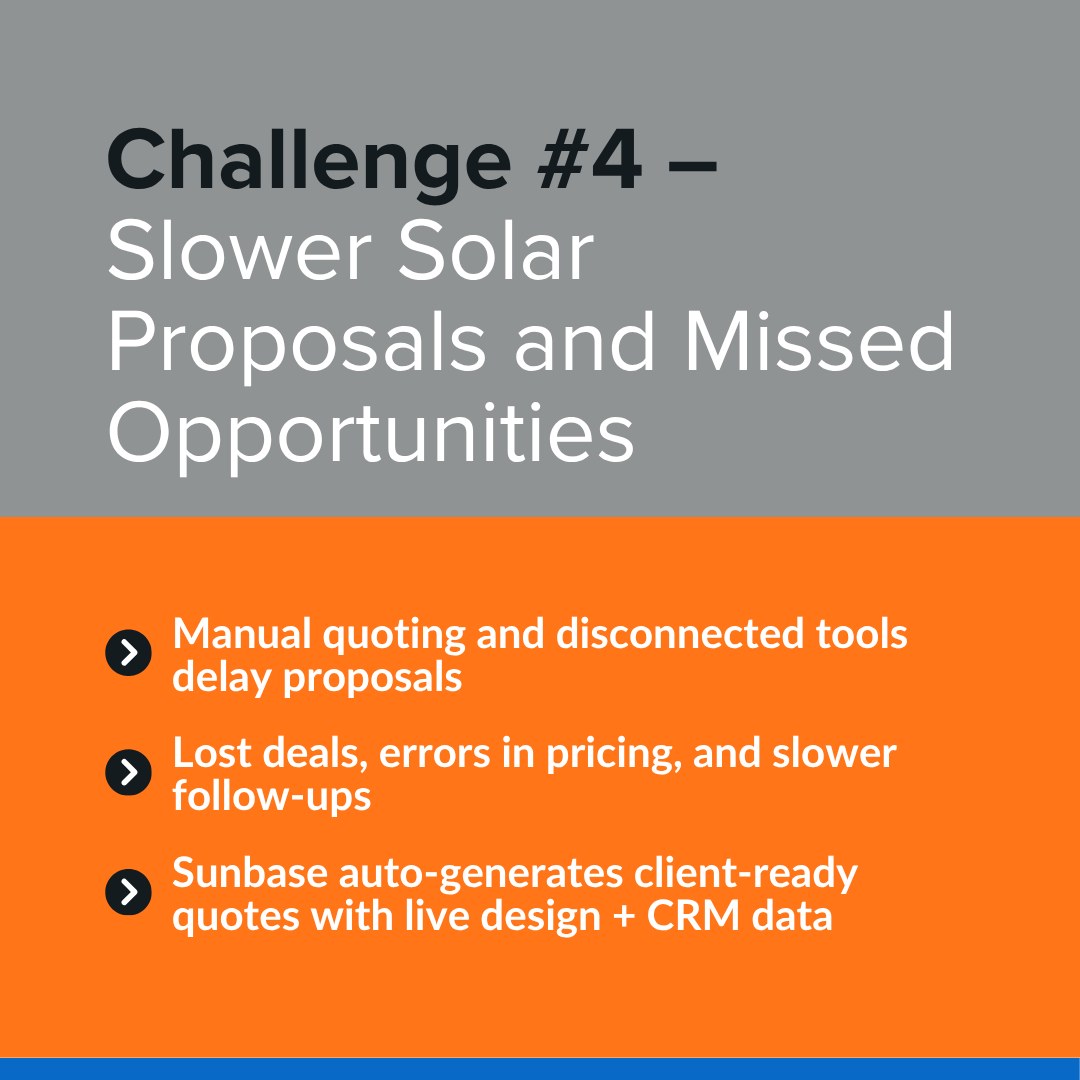
In the Canadian solar market, timing is everything. Delays in sending a proposal can mean losing the deal, especially when your competitor hits the inbox first.
And yet, many teams still rely on unsynced quoting tools, manual pricing sheets, and heavy design-export processes that kill momentum.
This isn’t just a sales problem. It’s a software problem.
A. Proposals Are Taking Too Long
A typical Canadian solar sales team is juggling:
- Site data in one tool
- System design in another
- Financials in a spreadsheet
- Legal disclaimers pulled from last week’s doc
- Final proposal stitched together in a PDF editor
Even with skilled reps, this process slows everything down. It can take hours, sometimes days, to generate a client-ready solar proposal. By then, the customer’s interest has cooled or they’ve moved on.
B. The Hidden Impact of Delayed Quotes
Here’s what happens when your proposal isn’t instant:
- Leads forget details from the original conversation
- Competitors win based on speed, not quality
- Follow-ups drag out because revisions are tedious
- Your brand feels disorganized or “not ready.”
This is especially risky in Canada’s growing residential and commercial solar segments, where customers are looking for clear, professional communication from day one.
C. Proposal Accuracy Also Takes a Hit
When pricing logic isn’t connected to your solar design software, mistakes happen:
- Quoting a 10kW system instead of the designed 9.6kW
- Missing tax logic for Quebec vs. Ontario
- Forgetting to include financing options or rebates
- Overpromising on energy yield due to copy-paste errors
These issues don’t just hurt sales; they damage trust.
D. Why Canadian Teams Need Smart Proposal Tools
Modern proposal tools should:
- Pull design data directly into the quote
- Auto-calculate pricing based on location, taxes, and size
- Support more deals with fast, beautiful client-ready documents
- Let reps make real-time edits without needing the design team
- Include localized language (English/French) and CAD formatting
Without this, even a great system design can fall apart at the sales stage.
E. How Sunbase Speeds Up the Sales Cycle
Sunbase turns slow quoting into a competitive advantage.
- Proposals auto-populate with system specs, pricing, and customer info
- Everything is connected to design, CRM, and project timelines
- Sales reps can generate, edit, and send proposals — all within one interface
- Templates are customizable to fit your brand, region, and financial model
Faster proposals lead to faster closes, resulting in stronger cash flow.
And for lean Canadian teams looking to scale? That speed matters more than ever.
Challenge #5 – No Clear View of Project Progress
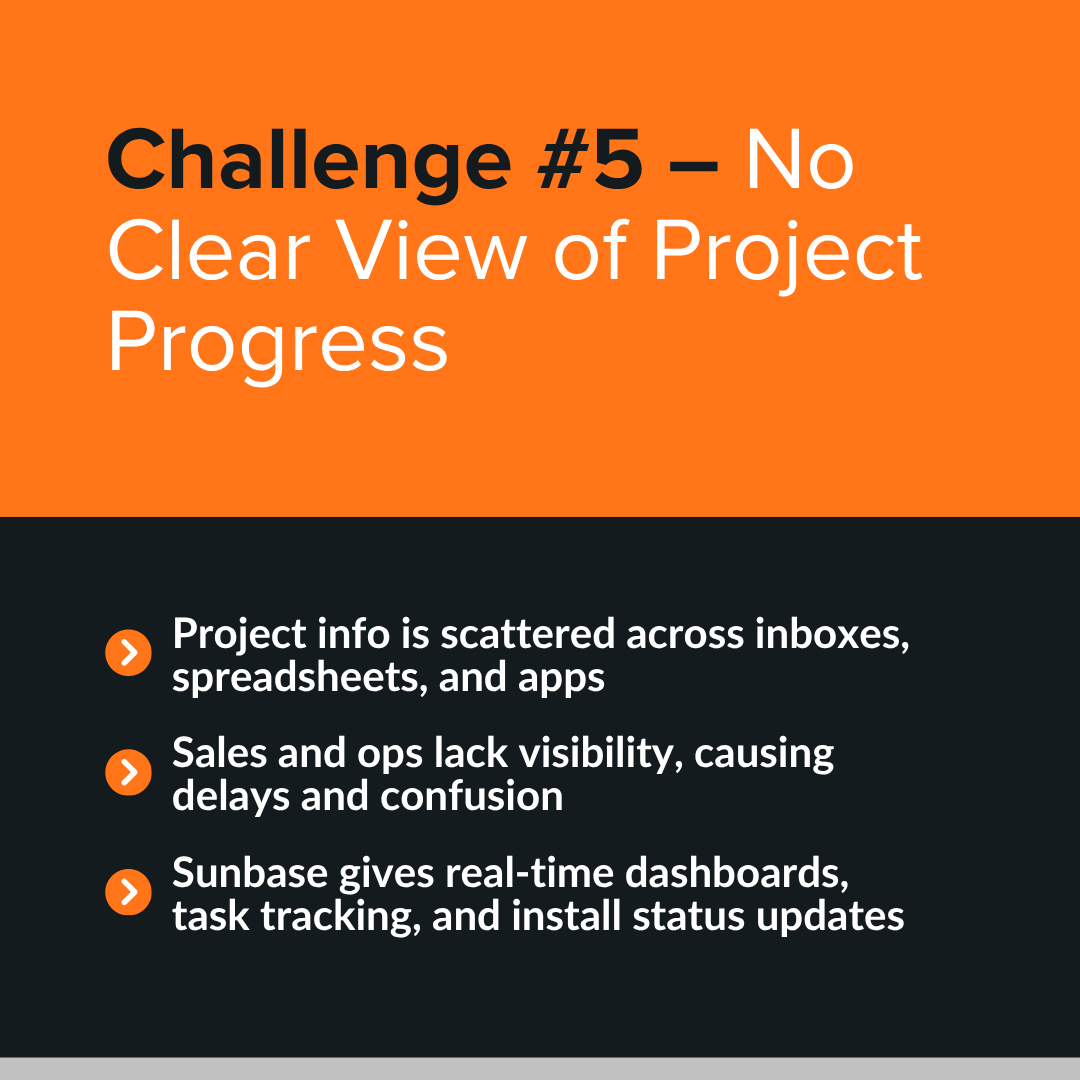
Canadian solar companies aren’t just selling systems; they’re managing complex, multi-phase projects that involve obtaining permits, conducting site visits, providing customer updates, and executing installations that can span weeks or even months.
But when your tools are scattered, getting a clear view of where any project stands becomes nearly impossible.
A. The Information Is There. But It's Everywhere
You might have:
- Proposal status in your CRM
- Site visit details in a Google Calendar
- Permit notes are buried in someone’s inbox
- Install checklists in a spreadsheet
- And updates are scattered across emails and Slack messages
This makes it difficult for any team member, sales, ops, or leadership, to understand where a job is in the pipeline.
B. The Cost of Disconnected Project Data
Without a unified project management software, teams struggle with:
- Missed permit deadlines
- Scheduling conflicts with install crews
- Lost customer confidence due to poor communication
- Delays in invoicing and final payment collection
- Repeating questions like “Has this job even started?”
The problem isn’t your team; it’s the lack of a centralized system that ties all project data together.
C. Scaling Without Visibility Is a Risk
As Canadian solar companies grow, the risks get bigger.
You can't afford to manage 20+ installs a month with spreadsheets and manual memory management. Even the leaders can’t forecast revenue or install timelines if they’re relying on fragmented updates.
And when you’re expanding across provinces or subcontracting to external crews, lack of visibility turns into operational chaos.
D. What a Centralized View Should Offer
A modern management software solution should give you:
- A single dashboard for all ongoing and completed projects
- Task assignments with deadlines and dependencies
- Integrated timelines that pull from CRM, proposals, and field ops
- Real-time updates and alerts when something stalls
- Province-specific install workflows and documentation tracking
This is how solar teams shift from reactive mode to proactive growth.
E. How Sunbase Delivers Project Visibility
Sunbase gives Canadian solar teams exactly that: clarity.
- Every project is visible from lead to install to payment
- Tasks are automatically generated and assigned based on the workflow stage
- Sales and ops can collaborate inside the same system
- Managers can track install timelines, team performance, and bottlenecks without chasing updates
What to Look for in a Solar Software Built for Canada

Most solar tools were built with the U.S. in mind, but Canadian solar businesses need software that aligns with their unique realities.
Here’s what to prioritize when choosing a platform that works in a Canadian context.
1. Built-In Compliance & Net Metering Logic
Your software should recognize the distinction between provinces, rather than treating Canada as a single, uniform region.
Look for:
- Province-specific documentation templates that will ensure teams always use the correct forms and legal requirements for each region, reducing errors and delays.
- Net metering eligibility flags
- Automatic reminders for key compliance steps
- Utility-specific output formatting adapts designs and reports to match the requirements of local utilities, avoiding rework and improving approval speed.
2. Full French-English Localization
If your team or customer base includes Quebec, bilingual functionality is non-negotiable.
The right tool will offer:
- A full French-language interface
- Dual-language proposal templates
- Adjustable tax and unit settings based on region
3. Connected CRM, Design, and Proposal Tools
You shouldn’t have to copy-paste between platforms. A Canada-ready tool will unify:
- CRM and lead tracking that will help capture, organize, and follow up with prospects efficiently
- Solar design software enables accurate system layouts, energy output estimates, and cost analysis
- Dynamic pricing and branded proposals
- Real-time project and install updates
This reduces friction across the entire sales and install cycle.
4. Project Visibility and Task Automation
As your team grows, you’ll need built-in project management software, not a separate system.
Look for:
- Central dashboards that will keep all project details in one place
- Automatic task assignment that will ensure that work is instantly delegated to the right team members
- Real-time project updates enable everyone to see changes as they occur, keeping the entire team and stakeholders aligned without the need for endless meetings.
- Install-ready checklists and internal notes to provide standardized processes and space for context
5. CAD-Ready Pricing and Tax Rules
You need proposal tools that work in CAD, calculate HST/GST/PST correctly, and adjust for region-specific pricing models. Anything else leads to rework and errors that lose deals.
6. Built for Lean Teams
Most Canadian solar companies don’t have huge back-office teams. The right software should help you scale without adding headcount by:
- Automating repetitive admin tasks
- Reducing data entry
- Giving every team member access to the info they need without the noise
7. Cloud-Based and Mobile-Accessible
Whether you’re in downtown Toronto or on a rural install in PEI, you need access anywhere. Look for platforms that are:
- Fully cloud-based
- Mobile- and tablet-friendly
- Secure and reliable, with fast load times across provinces
Also read: Why Canadian Solar Companies Are Investing in CRM & Automation in 2025
Conclusion
The Canadian solar market is full of potential, but most software tools haven’t caught up.
From net metering confusion and localization gaps to disjointed workflows and slow solar proposals, Canadian solar companies face a tech landscape that wasn’t built with them in mind.
But that’s changing. Platforms like Sunbase are bridging the gap, offering compliance-ready, bilingual, all-in-one systems that align with the way Canadian solar businesses operate. From design to CRM, project tracking to proposal generation, everything flows together.
And when your software supports your region, your team, and your growth, you scale faster, win more deals, and operate with confidence. Canada’s solar future deserves software that’s just as powerful.
Streamline Your Solar Business with Sunbase
Tired of switching between tools that don’t speak your language, literally or operationally?
Sunbase brings your entire workflow into one platform: from design to CRM, compliance to proposals, and install tracking to close. Built with Canadian solar teams in mind, including bilingual support, local tax logic, and region-specific customization.
Book a demo to see how Sunbase simplifies solar software for Canadian companies.
FAQs
1. Why is solar software in Canada more complex than in other regions?
Because every province has different rules, net metering policies, and permitting requirements, most off-the-shelf platforms are built for the U.S. and don’t adapt well to Canada’s regional complexity.
2. How does bilingual support impact solar teams in Canada?
In places like Quebec, French-language tools and documentation are essential. Without bilingual support, teams face slower proposals, internal miscommunication, and missed opportunities.
3. What makes Sunbase a good fit for Canadian solar companies?
Sunbase includes built-in support for provincial compliance, French and English workflows, CAD pricing logic, and all-in-one functionality, helping lean teams operate faster, smarter, and with less friction.
I agree to receive marketing messaging from Sunbase at the phone number provided above. I understand data rates will apply, and can reply STOP to OPT OUT.

